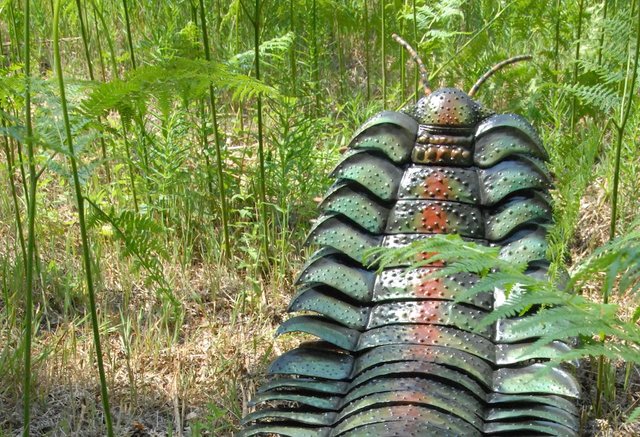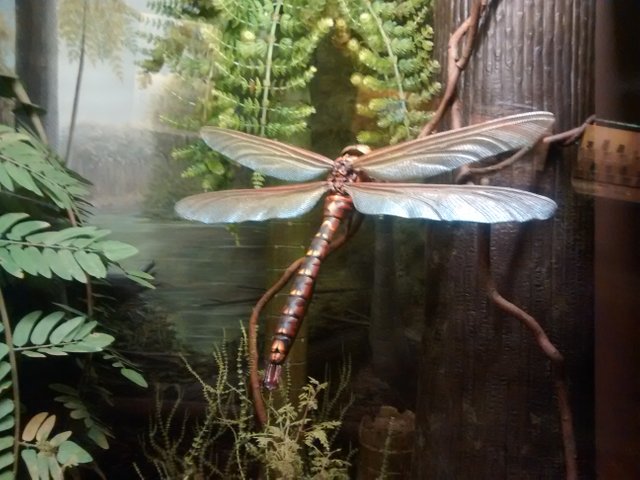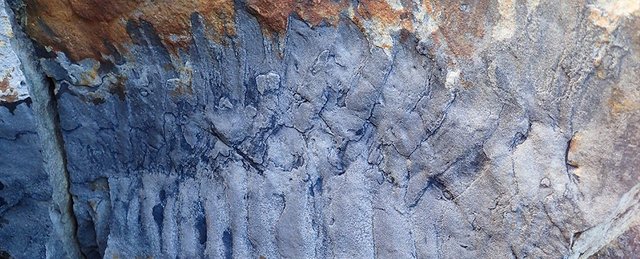Fossil of a car-sized millipede discovered/Descubierto fósil de un milpiés del tamaño de un auto

Source
The Carboniferous is a geological period belonging to the Paleozoic era in which it is located between the Devonian and the Permian, the Carboniferous begins 359 million years ago and ends 299 million years ago, it is characterized by large extensions of forest that were buried giving rise to , with the passage of millions of years, to the coal that today we extract from the mines.
El Carbonífero es un periodo geológico perteneciente a la era Paleozoica en la que se encuentra entre el Devónico y el Pérmico, el Carbonífero empieza hace 359 millones de años y termina hace 299 millones de años, se caracteriza porque grandes extensiones de bosque quedaron sepultadas dando lugar, con el paso de millones de años, al carbón que hoy extraemos de las minas.
One of the characteristics of this period is the high level of oxygen in the atmosphere, if today oxygen levels in the atmosphere are around 21% during the Carboniferous, concentrations of 35% of oxygen were reached, this allowed some insects will reach enormous sizes compared to current insects.
Una de las características de este periodo es el alto nivel de oxígeno en la atmósfera, si hoy en día los niveles de oxígeno en la atmósfera rondan el 21% durante el carbonífero se llegaron a alcazar concentraciones de 35 % de oxígenos, esto permitió que algunos insectos alcanzaran tamaños descomunales respecto a los insectos actuales.

Source
Insects like the Meganeura that you may have heard of, a dragonfly the size of an eagle or arthropods like the one that is news today, the size of a utility vehicle that roamed the forests of this period, it is the giant millipede (Arthropleura) that could reach 3 meters in length, 50 cm in diameter and up to 50 kg in weight.
Insectos como el Meganeura del que habréis oido hablar, una libélula del tamaño de un águila o artrópodos como el que hoy es noticia, del tamaño de un utilitario que deambulaba por los bosque de este periodo, se trata del milpiés gigante (Arthropleura) que podía alcanzar los 3 metros de longitud, 50 cm de diámetro y hasta 50 kg de peso.
Until this recent find there were only some fossilized remains of two specimens of giant millipedes but in this latest discovery in the north of England on Northumberland beach paleontologists have found the largest specimen cataloged to date and, according to its discoverers, it was a stroke of luck
Hasta este reciente hallazgo solo se contaba con algunos restos fosilizados de dos especímenes de milpiés gigante pero en este último descubrimiento en el norte de Inglaterra en la playa Northumberland los paleontólogos han encontrado el mayor especimen catalogado hasta la fecha y, según sus descubridores, fue un golpe de suerte.

Source
Normally, finding this type of fossil is very difficult because once dead these animals tend to disarticulate and degrade, so paleontologists intuit that it could just be a fossilized shell resulting from the shedding of skin of these arthropods in the same way as their current relatives, in fact the head has not been found.
Normalmente encontrar este tipo de fósiles es muy difícil porque una vez muertos estos animales suelen desarticularse y degradarse por lo que los paleontólogos intuyen que podría ser tan solo un caparazón fosilizado resultante de la muda de piel de estos artrópodos en la misma forma que lo hacen sus parientes actuales, de hecho no se ha encontrado la cabeza.
Although not many data are known about the way of life of this animal, experts assure that they fed on other invertebrates and even small amphibians, as they commented, it is very likely that its large size was due to the abundance of oxygen in the atmosphere but believes that other factors may have influenced its growth.
Aunque no se conocen muchos datos sobre el modo de vida de este animal los expertos aseguran que se alimentaban de otros invertebrados e incluso de pequeños anfibios, como comentaban es muy probable que su gran tamaño se debiera a la abundancia de oxígeno en la atmósfera pero se cree que es posible que otros factores influyeran en su crecimiento.
More information/Más información
https://today.in-24.com/News/765567.html
Hola @mauromar, menos mal ya no existen, porque si le tenemos miedo a los actuales que solo miden unos escasos centímetros no quiero ni imaginarme si me tropezase con uno de estos.

hello @mauromar,
I can't imagine how terrifying this insect was, in the prehistoric past of our planet lived many creatures that seem to come out of nightmares, I imagine that is why nowadays many people are afraid of small insects, it is possible that it is a fear inherited from past times where the insect did represent a real danger.
During the carboniferous period, as you mentioned in your publication, there was a high level of oxygen in the atmosphere, in which concentrations of 35% oxygen were reached, which as a consequence allowed some insects to reach enormous sizes, It is amazing to see an .incept of such enormous size. This allows me to remember also that the alteration of the temperature in this time of global warming will have as a consequence, among many others, the extinction of some insects and the proliferation of others, which will destroy the vegetation...
Thanks for such a great topic.
The discovery of fossils plays an important role from a scientific point of view, such as following up on geological events in history, rebuilding geographical conditions over time; it also allows us to know the variations from the climatic point of view.
Greetings @mauromar if in that period of time such a small species reached that size I do not want to imagine larger species by nature and constitution, we still have to unveil many mystery of prehistoric life,
Greetings...
Thank you @madridbg, have a nice 2022.
What does this discovery of the fossil mean ? Is it gonna incorporate a new kind of life into the ecosystem?
It seems the fossil the had before were not very good.
Oh! Thank u Sir.
The carboniferous was a period in which insects dominated the earth, it is known of huge dragonflies and giant scorpions, these findings allow us to continue discovering how fascinating the earth was at that time.
These giant insects look very scary. I'm just thinking, what if these kinds of insects return back again or what if the earth goes through another carboniferous era? Okay it sounds weird though :)
Nice piece buddy. Thanks for sharing
Wow, that first picture looks really scary.
Thank you for sharing.
Fossils helps us to know things about the past and about things and animals that exists in the past. Thanks to the help of science for the discovery.